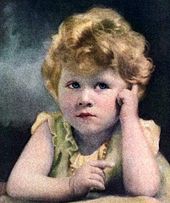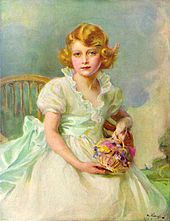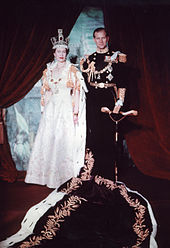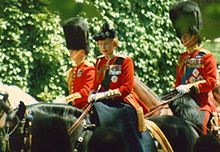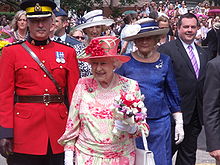
Elizabeth II
Background Information
SOS Children have produced a selection of wikipedia articles for schools since 2005. Click here for more information on SOS Children.
| Elizabeth II | |
|---|---|
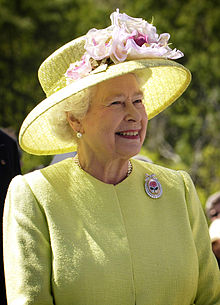 |
|
|
List
|
|
| Reign | 6 February 1952 – present |
| Coronation | 2 June 1953 |
| Predecessor | George VI |
| Heir apparent | Charles, Prince of Wales |
| Prime Ministers | See list |
| Spouse | Prince Philip, Duke of Edinburgh (m. 1947) |
| Issue | |
|
|
| Full name | |
| Elizabeth Alexandra Mary | |
| House | House of Windsor |
| Father | George VI |
| Mother | Elizabeth Bowes-Lyon |
| Born | 21 April 1926 Mayfair, London, England, United Kingdom |
| Religion |
|
Elizabeth II (Elizabeth Alexandra Mary; born 21 April 1926) is the constitutional monarch of 16 sovereign states, known as the Commonwealth realms, and their territories and dependencies, and head of the 54-member Commonwealth of Nations. She is Supreme Governor of the Church of England and, in some of her realms, carries the title of Defender of the Faith as part of her full title.
On her accession on 6 February 1952, Elizabeth became Head of the Commonwealth and queen regnant of seven independent Commonwealth countries: the United Kingdom, Canada, Australia, New Zealand, South Africa, Pakistan and Ceylon. From 1956 to 1992, the number of her realms varied as territories gained independence and some realms became republics. At present, in addition to the first four aforementioned countries, Elizabeth is Queen of Jamaica, Barbados, the Bahamas, Grenada, Papua New Guinea, the Solomon Islands, Tuvalu, Saint Lucia, Saint Vincent and the Grenadines, Belize, Antigua and Barbuda, and Saint Kitts and Nevis. Her reign of 61 years is currently the second longest for a British monarch; only Queen Victoria, her great-great grandmother, has reigned longer at over 63 years.
Elizabeth was born in London and educated privately at home. Her father acceded to the throne as George VI in 1936 on the abdication of his brother Edward VIII, from which time she was the heir presumptive. She began to undertake public duties during the Second World War, in which she served in the Auxiliary Territorial Service. In 1947, she married Prince Philip, Duke of Edinburgh, with whom she has four children: Charles, Anne, Andrew, and Edward. Her coronation service took place in 1953 and was the first to be televised.
Elizabeth II's many historic visits and meetings include a state visit to the Republic of Ireland and reciprocal visits to and from the Pope. Elizabeth has seen major constitutional changes in her realms, such as devolution in the United Kingdom and the patriation of the Canadian constitution. Times of personal significance have included the births and marriages of her children, the births of her grandchildren, the investiture of the Prince of Wales, and the celebration of milestones such as her Silver, Golden, and Diamond Jubilees in 1977, 2002, and 2012, respectively.
Major events in Elizabeth's reign have included the Troubles in Northern Ireland, the Falklands War, and wars with Iraq and in Afghanistan. There have been times of personal sorrow for her which include the death of her father at 56, the assassination of Prince Philip's uncle, Lord Mountbatten, the breakdown of her children's marriages in 1992 (a year deemed her annus horribilis), the death in 1997 of her son's former wife, Diana, Princess of Wales, and the deaths of her mother and sister in 2002. Elizabeth has occasionally faced severe press criticism of the royal family and republican sentiments, but support for the monarchy and her personal popularity remain high.
Early life
Elizabeth is the first child of Prince Albert, Duke of York (later King George VI), and his wife, Elizabeth. Her father was the second son of King George V and Queen Mary. Her mother was the youngest daughter of Scottish aristocrat Claude Bowes-Lyon, 14th Earl of Strathmore and Kinghorne. She was born by Caesarean section at 2.40 am (GMT) on 21 April 1926 at her maternal grandfather's London house: 17 Bruton Street, Mayfair. She was baptised by the Anglican Archbishop of York, Cosmo Gordon Lang, in the private chapel of Buckingham Palace on 29 May, and named Elizabeth after her mother, Alexandra after George V's mother, who had died six months earlier, and Mary after her paternal grandmother. Her close family called her "Lilibet". George V cherished his granddaughter, and during his serious illness in 1929 her regular visits were credited in the popular press and by later biographers with raising his spirits and aiding his recovery.
Elizabeth's only sibling, Princess Margaret, was four years younger. The two princesses were educated at home under the supervision of their mother and their governess, Marion Crawford, who was casually known as "Crawfie". Lessons concentrated on history, language, literature and music. To the dismay of the royal family, in 1950 Crawford published a biography of Elizabeth and Margaret's childhood years entitled The Little Princesses. The book describes Elizabeth's love of horses and dogs, her orderliness and her attitude of responsibility. Others echoed such observations: Winston Churchill described Elizabeth when she was two as "a character. She has an air of authority and reflectiveness astonishing in an infant." Her cousin Margaret Rhodes described her as "a jolly little girl, but fundamentally sensible and well-behaved".
Heiress presumptive
During her grandfather's reign, Elizabeth was third in the line of succession to the throne, behind her uncle Edward, Prince of Wales, and her father, the Duke of York. Although her birth generated public interest, she was not expected to become queen, as the Prince of Wales was still young and many assumed he would marry and have children of his own. In 1936, when her grandfather, George V, died and her uncle succeeded as Edward VIII, she became second in line to the throne after her father. Later that year, Edward abdicated after his proposed marriage to divorced socialite Wallis Simpson provoked a constitutional crisis. Elizabeth's father became king, and she became heiress presumptive. If her parents had had a later son, she would have lost her position as first in line as her brother would have been heir apparent and above her in the line of succession.
Elizabeth received private tuition in constitutional history from Henry Marten, Vice-Provost of Eton College, and learned French from a succession of native-speaking governesses. A Girl Guides company, the 1st Buckingham Palace Company, was formed specifically so she could socialise with girls her own age. Later she was enrolled as a Sea Ranger.
In 1939, Elizabeth's parents toured Canada and the United States. As in 1927, when her parents had toured Australia and New Zealand, Elizabeth remained in Britain, as her father thought her too young to undertake public tours. Elizabeth "looked tearful" as her parents departed. They corresponded regularly, and she and her parents made the first royal transatlantic telephone call on 18 May.
Second World War
In September 1939, Britain entered the Second World War, which lasted until 1945. During the war, London was frequently subject to aerial bombardment, and many of London's children were evacuated. The suggestion by senior politician Lord Hailsham that the two princesses should be evacuated to Canada was rejected by Elizabeth's mother, who declared, "The children won't go without me. I won't leave without the King. And the King will never leave." Princesses Elizabeth and Margaret stayed at Balmoral Castle, Scotland, until Christmas 1939, when they moved to Sandringham House, Norfolk. From February to May 1940, they lived at Royal Lodge, Windsor, until moving to Windsor Castle, where they lived for most of the next five years. At Windsor, the princesses staged pantomimes at Christmas in aid of the Queen's Wool Fund, which bought yarn to knit into military garments. In 1940, the 14-year-old Elizabeth made her first radio broadcast during the BBC's Children's Hour, addressing other children who had been evacuated from the cities. She stated:
We are trying to do all we can to help our gallant sailors, soldiers and airmen, and we are trying, too, to bear our share of the danger and sadness of war. We know, every one of us, that in the end all will be well.

In 1943, at the age of 16, Elizabeth undertook her first solo public appearance on a visit to the Grenadier Guards, of which she had been appointed Colonel-in-Chief the previous year. As she approached her 18th birthday, the law was changed so that she could act as one of five Counsellors of State in the event of her father's incapacity or absence abroad, such as his visit to Italy in July 1944. In February 1945, she joined the Women's Auxiliary Territorial Service, as an honorary Second Subaltern with the service number of 230873. She trained as a driver and mechanic and was promoted to honorary Junior Commander five months later.
At the end of the war in Europe, on Victory in Europe Day, the princesses Elizabeth and Margaret mingled anonymously with the celebratory crowds in the streets of London. Elizabeth later said in a rare interview, "We asked my parents if we could go out and see for ourselves. I remember we were terrified of being recognised ... I remember lines of unknown people linking arms and walking down Whitehall, all of us just swept along on a tide of happiness and relief."
During the war, plans were drawn up to quell Welsh nationalism by affiliating Elizabeth more closely with Wales. Proposals, such as appointing her Constable of Caernarvon Castle or a patron of Urdd Gobaith Cymru (the Welsh League of Youth), were abandoned for various reasons, which included a fear of associating Elizabeth with conscientious objectors in the Urdd, at a time when Britain was at war. Welsh politicians suggested that she be made Princess of Wales on her 18th birthday. The idea was supported by Home Secretary Herbert Morrison, but rejected by the King because he felt such a title belonged solely to the wife of a Prince of Wales, and the Prince of Wales had always been the heir apparent. In 1946, she was inducted into the Welsh Gorsedd of Bards at the National Eisteddfod of Wales.
In 1947 Princess Elizabeth made her first overseas tour, accompanying her parents through southern Africa. During the tour, in a broadcast to the British Commonwealth on her 21st birthday, she made the following pledge:
"I declare before you all that my whole life, whether it be long or short, shall be devoted to your service and the service of our great imperial family to which we all belong."
Marriage
Elizabeth met her future husband, Prince Philip of Greece and Denmark, in 1934 and 1937. They are second cousins once removed through King Christian IX of Denmark and third cousins through Queen Victoria. After another meeting at the Royal Naval College in Dartmouth in July 1939, Elizabeth—though only 13 years old—said she fell in love with Philip and they began to exchange letters. Their engagement was officially announced on 9 July 1947.
The engagement was not without controversy: Philip had no financial standing, was foreign-born (though a British subject who had served in the Royal Navy during the Second World War), and had sisters who had married German noblemen with Nazi links. Marion Crawford wrote, "Some of the King's advisors did not think him good enough for her. He was a prince without a home or kingdom. Some of the papers played long and loud tunes on the string of Philip's foreign origin." Elizabeth's mother was reported, in later biographies, to have opposed the union initially, even dubbing Philip " The Hun". In later life, however, she told biographer Tim Heald that Philip was "an English gentleman".
Before the marriage, Philip renounced his Greek and Danish titles, converted from Greek Orthodoxy to Anglicanism, and adopted the style Lieutenant Philip Mountbatten, taking the surname of his mother's British family. Just before the wedding, he was created Duke of Edinburgh and granted the style His Royal Highness.
Elizabeth and Philip were married on 20 November 1947 at Westminster Abbey. They received 2500 wedding gifts from around the world. Because Britain had not yet completely recovered from the devastation of the war, Elizabeth required ration coupons to buy the material for her gown, which was designed by Norman Hartnell. In post-war Britain, it was not acceptable for the Duke of Edinburgh's German relations, including his three surviving sisters, to be invited to the wedding. The Duke of Windsor, formerly King Edward VIII, was not invited.
Elizabeth gave birth to her first child, Prince Charles, on 14 November 1948. One month earlier, the King had issued letters patent allowing her children to use the style and title of a royal prince or princess, to which they otherwise would not have been entitled as their father was no longer a royal prince. A second child, Princess Anne, was born in 1950.
Following their wedding, the couple leased Windlesham Moor, near Windsor Castle, until 4 July 1949, when they took up residence at Clarence House in London. At various times between 1949 and 1951, the Duke of Edinburgh was stationed in the British Protectorate of Malta as a serving Royal Navy officer. He and Elizabeth lived intermittently, for several months at a time, in the Maltese hamlet of Gwardamanġia, at the Villa Gwardamanġia, the rented home of Philip's uncle, Lord Mountbatten. The children remained in Britain.
Reign
Accession and coronation
During 1951, George VI's health declined and Elizabeth frequently stood in for him at public events. When she toured Canada and visited President Truman in Washington, D.C. in October 1951, her private secretary, Martin Charteris, carried a draft accession declaration for use if the King died while she was on tour. In early 1952, Elizabeth and Philip set out for a tour of Australia and New Zealand by way of Kenya. On 6 February 1952, they had just returned to their Kenyan home, Sagana Lodge, after a night spent at Treetops Hotel, when word arrived of the death of the King. Philip broke the news to the new queen. Martin Charteris asked her to choose a regnal name; she chose to remain Elizabeth, "of course". She was proclaimed queen throughout her realms and the royal party hastily returned to the United Kingdom. She and the Duke of Edinburgh moved into Buckingham Palace.
With Elizabeth's accession, it seemed probable that the royal house would bear her husband's name, becoming the House of Mountbatten, in line with the custom of a wife taking her husband's surname on marriage. Elizabeth's grandmother, Queen Mary, and British Prime Minister Winston Churchill favoured the retention of the House of Windsor, and so Windsor it remained. The Duke complained, "I am the only man in the country not allowed to give his name to his own children." In 1960, after the death of Queen Mary in 1953 and the resignation of Churchill in 1955, the surname Mountbatten-Windsor was adopted for Philip and Elizabeth's male-line descendants who do not carry royal titles.
| The Royal Family of the United Kingdom and the other Commonwealth realms |
|---|
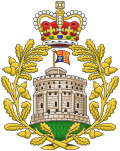 |
|
HM The Queen
|
Amid preparations for the coronation, Princess Margaret informed her sister that she wished to marry Peter Townsend, a divorcee 16 years Margaret's senior, with two sons from his previous marriage. The Queen asked them to wait for a year; in the words of Martin Charteris, "the Queen was naturally sympathetic towards the Princess, but I think she thought—she hoped—given time, the affair would peter out." Senior politicians were against the match and the Church of England did not permit re-marriage after divorce. If Margaret contracted a civil marriage, she would be expected to renounce her right of succession. Eventually, she decided to abandon her plans with Townsend. In 1960, she married Antony Armstrong-Jones, who was created Earl of Snowdon the following year. They were divorced in 1978; she did not remarry.
Despite the death of Queen Mary on 24 March, the coronation went ahead, as Mary had asked before she died, taking place as planned on 2 June 1953. The ceremony in Westminster Abbey, with the exception of the anointing and communion, was televised for the first time. Elizabeth's coronation gown was commissioned from Norman Hartnell and embroidered on her instructions with the floral emblems of the Commonwealth countries: English Tudor rose; Scots thistle; Welsh leek; Irish shamrock; Australian wattle; Canadian maple leaf; New Zealand silver fern; South African protea; lotus flowers for India and Ceylon; and Pakistan's wheat, cotton, and jute.
Continuing evolution of the Commonwealth

The Queen witnessed, over her life, the ongoing transformation of the British Empire into the Commonwealth of Nations. By the time of her accession in 1952, her role as head of multiple independent states was already established. Spanning 1953–54, the Queen and her husband embarked on a six-month around-the-world tour. She became the first reigning monarch of Australia and New Zealand to visit those nations. During the tour, crowds were immense; three-quarters of the population of Australia were estimated to have seen her. Throughout her reign, the Queen has undertaken state visits to foreign countries and tours of Commonwealth ones and she is the most widely travelled head of state in history.
In 1956, French Prime Minister Guy Mollet and British Prime Minister Sir Anthony Eden discussed the possibility of France joining the Commonwealth. The proposal was never accepted and the following year France signed the Treaty of Rome, which established the European Economic Community, the precursor of the European Union. In November 1956, Britain and France invaded Egypt in an ultimately unsuccessful attempt to capture the Suez Canal. Lord Mountbatten claimed the Queen was opposed to the invasion, though Eden denied it. Eden resigned two months later.
The absence of a formal mechanism within the Conservative Party for choosing a leader meant that, following Eden's resignation, it fell to the Queen to decide whom to commission to form a government. Eden recommended that she consult Lord Salisbury, the Lord President of the Council. Lord Salisbury and Lord Kilmuir, the Lord Chancellor, consulted the British Cabinet, Winston Churchill, and the Chairman of the backbench 1922 Committee, as a result of which the Queen appointed their recommended candidate: Harold Macmillan.
The Suez crisis and the choice of Eden's successor led in 1957 to the first major personal criticism of the Queen. In a magazine, which he owned and edited, Lord Altrincham accused her of being "out of touch". Altrincham was denounced by public figures and physically attacked by a member of the public appalled at his comments. Six years later, in 1963, Macmillan resigned and advised the Queen to appoint the Earl of Home as prime minister, advice that she followed. The Queen again came under criticism for appointing the prime minister on the advice of a small number of ministers or a single minister. In 1965, the Conservatives adopted a formal mechanism for electing a leader, thus relieving her of involvement.
In 1957, she made a state visit to the United States, where she addressed the United Nations General Assembly on behalf of the Commonwealth. On the same tour, she opened the 23rd Canadian parliament, becoming the first monarch of Canada to open a parliamentary session. Two years later, solely in her capacity as Queen of Canada, she revisited the United States and toured Canada, despite learning upon landing at St. John's, Newfoundland, that she was pregnant with her third child. In 1961, she toured Cyprus, India, Pakistan, Nepal, and Iran. On a visit to Ghana the same year, she dismissed fears for her safety, even though her host, President Kwame Nkrumah, who had replaced her as head of state, was a target for assassins. Harold Macmillan wrote, "The Queen has been absolutely determined all through ... She is impatient of the attitude towards her to treat her as ... a film star ... She has indeed ' the heart and stomach of a man' ... She loves her duty and means to be a Queen." Before her tour through parts of Quebec in 1964, the press reported that extremists within the Quebec separatist movement were plotting Elizabeth's assassination. No attempt was made, but a riot did break out while she was in Montreal; the Queen's "calmness and courage in the face of the violence" was noted.
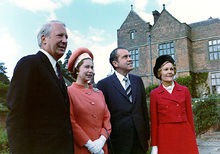
Elizabeth's pregnancies with Princes Andrew and Edward, in 1959 and 1963, mark the only times she has not performed the State Opening of the British parliament during her reign. In addition to performing traditional ceremonies, she also instituted new practices. Her first royal walkabout, meeting ordinary members of the public, took place during a tour of Australia and New Zealand in 1970.
The 1960s and 1970s saw an acceleration in the decolonisation of Africa and the Caribbean. Over 20 countries gained independence from Britain as part of a planned transition to self-government. In 1965, however, Rhodesian Prime Minister Ian Smith, in opposition to moves toward majority rule, declared unilateral independence from Britain while still expressing "loyalty and devotion" to Elizabeth. Although the Queen dismissed him in a formal declaration, and the international community applied sanctions against Rhodesia, his regime survived for over a decade.
In February 1974, British Prime Minister Edward Heath advised the Queen to call a general election in the middle of her tour of the Austronesian Pacific Rim, requiring her to fly back to Britain. The election resulted in a hung parliament; Heath's Conservatives were not the largest party, but could stay in office if they formed a coalition with the Liberals. Heath only resigned when discussions on forming a coalition foundered, after which the Queen asked the Leader of the Opposition, Labour's Harold Wilson, to form a government.
A year later, at the height of the 1975 Australian constitutional crisis, Australian Prime Minister Gough Whitlam was dismissed from his post by Governor-General Sir John Kerr, after the Opposition-controlled Senate rejected Whitlam's budget proposals. As Whitlam had a majority in the House of Representatives, Speaker Gordon Scholes appealed to the Queen to reverse Kerr's decision. She declined, stating that she would not interfere in decisions reserved by the Constitution of Australia for the governor-general. The crisis fuelled Australian republicanism.
Silver Jubilee
In 1977, Elizabeth marked the Silver Jubilee of her accession. Parties and events took place throughout the Commonwealth, many coinciding with her associated national and Commonwealth tours. The celebrations re-affirmed the Queen's popularity, despite virtually coincident negative press coverage of Princess Margaret's separation from her husband. In 1978, the Queen endured a state visit to the United Kingdom by Romania's communist dictator Nicolae Ceaușescu and his wife Elena, though privately she thought they had "blood on their hands". The following year brought two blows: one was the unmasking of Anthony Blunt, former Surveyor of the Queen's Pictures, as a communist spy; the other was the assassination of her relative and in-law Lord Mountbatten by the Provisional Irish Republican Army.
According to Paul Martin, Sr., by the end of the 1970s the Queen was worried the Crown "had little meaning for" Canadian Prime Minister Pierre Trudeau. Tony Benn said that the Queen found Trudeau "rather disappointing". Trudeau's supposed republicanism seemed to be confirmed by his antics, such as sliding down banisters at Buckingham Palace and pirouetting behind the Queen's back in 1977, and the removal of various Canadian royal symbols during his term of office. In 1980, Canadian politicians sent to London to discuss the patriation of the Canadian constitution found the Queen "better informed ... than any of the British politicians or bureaucrats". She was particularly interested after the failure of Bill C-60, which would have affected her role as head of state. Patriation removed the role of the British parliament from the Canadian constitution, but the monarchy was retained. Trudeau said in his memoirs that the Queen favoured his attempt to reform the constitution and that he was impressed by "the grace she displayed in public" and "the wisdom she showed in private".
1980s
During the 1981 Trooping the Colour ceremony and only six weeks before the wedding of Charles, Prince of Wales, and Lady Diana Spencer, six shots were fired at the Queen from close range as she rode down The Mall on her horse, Burmese. Police later discovered that the shots were blanks. The 17-year-old assailant, Marcus Sarjeant, was sentenced to five years in prison and released after three. The Queen's composure and skill in controlling her mount were widely praised. From April to September 1982, the Queen remained anxious but proud of her son, Prince Andrew, who was serving with British forces during the Falklands War. On 9 July, the Queen awoke in her bedroom at Buckingham Palace to find an intruder, Michael Fagan, in the room with her. Remaining calm and through two calls to the palace police switchboard, she spoke to Fagan while he sat at the foot of her bed until assistance arrived seven minutes later. Though she hosted US President Ronald Reagan at Windsor Castle in 1982 and visited his Californian ranch in 1983, she was angered when his administration ordered the invasion of Grenada, one of her Caribbean realms, without informing her.
Intense media interest in the opinions and private lives of the royal family during the 1980s led to a series of sensational stories in the press, not all of which were entirely true. As Kelvin MacKenzie, editor of The Sun, told his staff: "Give me a Sunday for Monday splash on the Royals. Don't worry if it's not true—so long as there's not too much of a fuss about it afterwards." Newspaper editor Donald Trelford wrote in The Observer of 21 September 1986: "The royal soap opera has now reached such a pitch of public interest that the boundary between fact and fiction has been lost sight of ... it is not just that some papers don't check their facts or accept denials: they don't care if the stories are true or not." It was reported, most notably in The Sunday Times of 20 July 1986, that the Queen was worried that British Prime Minister Margaret Thatcher's economic policies fostered social divisions and was alarmed by high unemployment, a series of riots, the violence of a miners' strike, and Thatcher's refusal to apply sanctions against the apartheid regime in South Africa. The sources of the rumours included royal aide Michael Shea and Commonwealth Secretary-General Shridath Ramphal, but Shea claimed his remarks were taken out of context and embellished by speculation. Thatcher reputedly said the Queen would vote for the Social Democratic Party—Thatcher's political opponents. Thatcher's biographer John Campbell claimed "the report was a piece of journalistic mischief-making". Belying reports of acrimony between them, Thatcher later conveyed her personal admiration for the Queen and, after Thatcher's replacement as prime minister by John Major, the Queen gave two honours in her personal gift to Thatcher: appointment to the Order of Merit and the Order of the Garter. Former Canadian prime minister Brian Mulroney said Elizabeth was a "behind the scenes force" in ending apartheid in South Africa.
In 1987, in Canada, Elizabeth publicly pronounced her support for that country's politically divisive Meech Lake Accord, prompting criticism from opponents of the constitutional amendments, including Pierre Trudeau. The same year, the elected Fijian government was deposed in a military coup. Elizabeth, as monarch of Fiji, supported the attempts of the Governor-General, Ratu Sir Penaia Ganilau, to assert executive power and negotiate a settlement. Coup leader Sitiveni Rabuka deposed Ganilau and declared Fiji a republic. By the start of 1991, republican feeling in Britain had risen because of press estimates of the Queen's private wealth—which were contradicted by the palace—and reports of affairs and strained marriages among her extended family. The involvement of the younger royals in the charity game show It's a Royal Knockout was ridiculed and the Queen was the target of satire.
1990s
In 1991, in the wake of victory in the Gulf War, Elizabeth became the first British monarch to address a joint session of the United States Congress.
In a speech on 24 November 1992, to mark the 40th anniversary of her accession, Elizabeth called 1992 her annus horribilis, meaning horrible year. In March, her second son Prince Andrew, Duke of York, and his wife Sarah, Duchess of York, separated; in April, her daughter Anne, Princess Royal, divorced her husband Captain Mark Phillips; during a state visit to Germany in October, angry demonstrators in Dresden threw eggs at her; and, in November, Windsor Castle suffered severe fire damage. The monarchy received increased criticism and public scrutiny. In an unusually personal speech, the Queen said that any institution must expect criticism, but suggested it be done with "a touch of humour, gentleness and understanding". Two days later, Prime Minister John Major announced reforms of the royal finances that had been planned since the previous year, including the Queen paying income tax for the first time from 1993 and a reduction in the civil list. In December, Charles, Prince of Wales, and his wife, Diana, Princess of Wales, formally separated. The year ended with a lawsuit as the Queen sued The Sun newspaper for breach of copyright when it published the text of her annual Christmas message two days before its broadcast. The newspaper was forced to pay her legal fees and donated £200,000 to charity.
In the ensuing years, public revelations on the state of Charles and Diana's marriage continued. Even though support for republicanism in Britain seemed higher than at any time in living memory, republicanism remained a minority viewpoint and the Queen herself had high approval ratings. Criticism was focused on the institution of monarchy itself and the Queen's wider family rather than the Queen's own behaviour and actions. In consultation with Prime Minister Major, Archbishop of Canterbury George Carey, her private secretary Robert Fellowes and her husband, she wrote to Charles and Diana at the end of December 1995, saying that a divorce was desirable. A year after the divorce, which took place in 1996, Diana was killed in a car crash in Paris on 31 August 1997. The Queen was on holiday with her son and grandchildren at Balmoral. Diana's two sons wanted to attend church and so the Queen and Prince Philip took them that morning. After that single public appearance, for five days the Queen and the Duke shielded their grandsons from the intense press interest by keeping them at Balmoral where they could grieve in private, but the royal family's seclusion and a failure to fly a flag at half-mast over Buckingham Palace caused public dismay. Pressured by the hostile reaction, the Queen agreed to a live broadcast to the world and returned to London to deliver it on 5 September, the day before Diana's funeral. In the broadcast, she expressed admiration for Diana and her feelings "as a grandmother" for Princes William and Harry. As a result, much of the public hostility evaporated.
Golden Jubilee
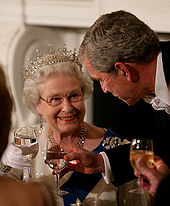
In 2002, Elizabeth marked her Golden Jubilee as queen. Her sister and mother died in February and March, respectively, and the media speculated as to whether the Jubilee would be a success or a failure. She again undertook an extensive tour of her realms, which began in Jamaica in February, where she called the farewell banquet "memorable" after a power cut plunged the King's House, the official residence of the governor-general, into darkness. As in 1977, there were street parties and commemorative events and monuments were named to honour the occasion. A million people attended each day of the three-day main Jubilee celebration in London and the enthusiasm shown by the public for the Queen was greater than many journalists had predicted.
Though generally healthy throughout her life, in 2003 she had keyhole surgery on both knees. In October 2006, she missed the opening of the new Emirates Stadium because of a strained back muscle that had been troubling her since the summer.
In May 2007, The Daily Telegraph newspaper reported claims from unnamed sources that the Queen was "exasperated and frustrated" by the policies of British Prime Minister Tony Blair, that she had shown concern that the British Armed Forces were overstretched in Iraq and Afghanistan, and that she had raised concerns over rural and countryside issues with Blair repeatedly. She was, however, said to admire Blair's efforts to achieve peace in Northern Ireland. On 20 March 2008, at the Church of Ireland St Patrick's Cathedral, Armagh, the Queen attended the first Maundy service held outside England and Wales. At the invitation of Irish President Mary McAleese, the Queen in May 2011 made the first state visit to the Republic of Ireland by a British monarch.
The Queen addressed the United Nations for a second time in 2010, again in her capacity as queen of all Commonwealth realms and Head of the Commonwealth. UN Secretary General Ban Ki-moon introduced her as "an anchor for our age". During her visit to New York, which followed a tour of Canada, she officially opened a memorial garden for the British victims of the 11 September attacks. The Queen's visit to Australia in October 2011, her 16th since 1954, was called her "farewell tour" in the press because of her age.
Diamond Jubilee and beyond
Elizabeth's Diamond Jubilee in 2012 marked 60 years as queen, with celebrations throughout her realms, the wider Commonwealth, and beyond. In a message released on Accession Day, she stated: "In this special year, as I dedicate myself anew to your service, I hope we will all be reminded of the power of togetherness and the convening strength of family, friendship and good neighbourliness ... I hope also that this Jubilee year will be a time to give thanks for the great advances that have been made since 1952 and to look forward to the future with clear head and warm heart". She and her husband undertook an extensive tour of the United Kingdom, while her children and grandchildren embarked on royal tours of other Commonwealth states on her behalf. On 4 June, jubilee beacons were lit around the world.
The Queen opened the 2012 Summer Olympics on 27 July and the Paralympics on 29 August 2012 in London, making her the first head of state to open two Olympic Games in two different countries. For the London Olympics, she played herself in a short film as part of the opening ceremony, alongside Daniel Craig as James Bond. On 4 April 2013, she received an honorary BAFTA for her patronage of the film industry and was called "the most memorable Bond girl yet" at the award ceremony.
On 18 December 2012, the Queen became the first British sovereign to attend a peace-time Cabinet meeting since King George III in 1781. Foreign Secretary William Hague announced shortly after that the previously unnamed southern part of the British Antarctic Territory had been named Queen Elizabeth Land in her honour.
On 3 March 2013, she was admitted to the King Edward VII Hospital for assessment as a precaution after developing symptoms of gastroenteritis. She returned to Buckingham Palace the following day. Due to her advanced age and the need for her to limit travelling, she will not be attending the 2013 biennial meeting of Commonwealth heads of government to be held in November in Sri Lanka; it will be the first time since 1973 that she has not attended the meeting. She will be represented at the summit by her son, the Prince of Wales.
She is the longest-lived and second-longest-reigning monarch of the United Kingdom and the second-longest-serving current head of state (after King Bhumibol Adulyadej of Thailand). She does not intend to abdicate.
Public perception and character
Since Elizabeth rarely gives interviews, little is known of her personal feelings. As a constitutional monarch, she has not expressed her own political opinions in a public forum. She does have a deep sense of religious and civic duty and takes her coronation oath seriously. Aside from her official religious role as Supreme Governor of the established Church of England, she personally worships with that church and with the national Church of Scotland. She has demonstrated support for inter-faith relations and has met with leaders of other churches and religions, including three popes: John XXIII, John Paul II and Benedict XVI. A personal note about her faith often features in her annual Royal Christmas Message broadcast to the Commonwealth, such as in 2000, when she spoke about the theological significance of the millennium marking the 2000th anniversary of the birth of Jesus Christ:
To many of us, our beliefs are of fundamental importance. For me the teachings of Christ and my own personal accountability before God provide a framework in which I try to lead my life. I, like so many of you, have drawn great comfort in difficult times from Christ's words and example.
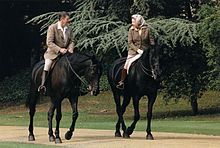
She is the patron of over 600 organisations and charities. Her main leisure interests include equestrianism and dogs, especially her Pembroke Welsh Corgis. Her lifelong love of corgis began in 1933 with Dookie, the first corgi owned by her family. Scenes of a relaxed, informal home life have occasionally been witnessed; she and her family, from time to time, prepare a meal together and do the washing up afterwards.
In the 1950s, as a young woman at the start of her reign, Elizabeth was depicted as a glamorous "fairytale Queen". After the trauma of the war, it was a time of hope, a period of progress and achievement heralding a "new Elizabethan age". Lord Altrincham's accusation in 1957 that her speeches sounded like those of a "priggish schoolgirl" was an extremely rare criticism. In the late 1960s, attempts to portray a more modern image of monarchy were made in the television documentary Royal Family and by televising Prince Charles's investiture as Prince of Wales. She took to wearing in public clothes that consist mostly of solid-colour overcoats and decorative hats, which allow her to be seen easily in a crowd.
At her Silver Jubilee in 1977, the crowds and celebrations were genuinely enthusiastic, but in the 1980s public criticism of the royal family increased, as the personal and working lives of Elizabeth's children came under media scrutiny. Elizabeth's popularity sank to a low point in the 1990s. Under pressure from public opinion, she began to pay income tax for the first time and Buckingham Palace was opened to the public. Discontent with the monarchy reached its peak on the death of Diana, Princess of Wales, though Elizabeth's personal popularity and support for the monarchy rebounded after her live broadcast to the world five days after Diana's death.
In November 1999, a referendum in Australia on the future of the Australian monarchy favoured its retention in preference to an indirectly elected head of state. Polls in Britain in 2006 and 2007 revealed strong support for Elizabeth, and referenda in Tuvalu in 2008 and Saint Vincent and the Grenadines in 2009 both rejected proposals to become republics.
Elizabeth has been portrayed in a variety of mediums by many notable artists during her reign, including painters Lucian Freud, Peter Blake, Juliet Pannett, Chinwe Chukwuogo-Roy, Terence Cuneo, Tai-Shan Schierenberg and Pietro Annigoni. Notable photographers of Elizabeth have included Cecil Beaton, Yousuf Karsh, Lord Lichfield, Terry O'Neill and John Swannell. The first official portrait of Elizabeth was taken by Marcus Adams.
Finances
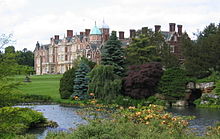
Elizabeth's personal fortune has been the subject of speculation for many years. Forbes magazine estimated her net worth at around US$450 million in 2010, but official Buckingham Palace statements in 1993 called estimates of £100 million "grossly overstated". Jock Colville, who was her former private secretary and a director of her bank, Coutts, estimated her wealth in 1971 at £2 million (the equivalent of about £21 million today). The Royal Collection (which includes artworks and the Crown Jewels) is not owned by the Queen personally and is held in trust, as are the occupied palaces, such as Buckingham Palace and Windsor Castle, and the Duchy of Lancaster, a property portfolio valued in 2011 at £383 million. Sandringham House and Balmoral Castle are privately owned by the Queen. The British Crown Estate—with holdings of £7.3 billion in 2011—is held in trust for the nation and cannot be sold or owned by Elizabeth in a private capacity.
Titles, styles, honours and arms
Titles and styles
Elizabeth has held many titles and honorary military positions throughout the Commonwealth, is Sovereign of many orders in her own countries, and has received honours and awards from around the world. Officially, she has a distinct title in each of her realms: Queen of Jamaica in Jamaica, Queen of Australia in Australia, etc. In the Channel Islands and Isle of Man, which are Crown dependencies rather than separate realms, she is known as Duke of Normandy and Lord of Mann, respectively. Additional styles include Defender of the Faith and Duke of Lancaster. When in conversation with the Queen, the practice is to initially address her as Your Majesty and thereafter as Ma'am.
Arms
From 21 April 1944 until her accession, Elizabeth's arms consisted of a lozenge bearing the royal coat of arms of the United Kingdom differenced with a label of three points argent, the centre point bearing a Tudor rose and the first and third a cross of St George. Upon her accession, she inherited the various arms her father held as sovereign. The Queen also possesses royal standards and personal flags for use in the United Kingdom, Canada, Australia, New Zealand, Jamaica, Barbados, and elsewhere.
Issue
| Name | Birth | Marriage | Children | Grandchildren | |
|---|---|---|---|---|---|
| Prince Charles, Prince of Wales | 14 November 1948 | 29 July 1981 Divorced 28 August 1996 |
Lady Diana Spencer | Prince William, Duke of Cambridge Prince Harry of Wales |
|
| 9 April 2005 | Camilla Shand | ||||
| Princess Anne, Princess Royal | 15 August 1950 | 14 November 1973 Divorced 28 April 1992 |
Mark Phillips | Peter Phillips | Savannah Phillips Isla Phillips |
| Zara Phillips | |||||
| 12 December 1992 | Timothy Laurence | ||||
| Prince Andrew, Duke of York | 19 February 1960 | 23 July 1986 Divorced 30 May 1996 |
Sarah Ferguson | Princess Beatrice of York Princess Eugenie of York |
|
| Prince Edward, Earl of Wessex | 10 March 1964 | 19 June 1999 | Sophie Rhys-Jones | Lady Louise Windsor James, Viscount Severn |
|
Ancestry
| Ancestors of Elizabeth II | ||||||||||||||||||||||||||||||||||||||||||||||||||||||||||||||||||||||||||||||||||||||||||||||||||||||||||||||||||||||||||||||||||||||||||||||||||||||||||||||||||||||||||||||||||||||||||||||||||||||||||||||||||||||||||||||||||||||||||||||||||||||||||||||||||||||||||||||||||||||||||||||||||||||||||||||||||||||||||||||||||||||||||||||||||||||||||||||||||||||||||||||||||||||||||||||||||||||||||||||||||||||||||||||||||||||||||||||||||||||||||||||||||||||||||||||||||||||||||||||||||||||||||||||||||||||||||||||||||||||||||||||||||||||||||||||||||
|---|---|---|---|---|---|---|---|---|---|---|---|---|---|---|---|---|---|---|---|---|---|---|---|---|---|---|---|---|---|---|---|---|---|---|---|---|---|---|---|---|---|---|---|---|---|---|---|---|---|---|---|---|---|---|---|---|---|---|---|---|---|---|---|---|---|---|---|---|---|---|---|---|---|---|---|---|---|---|---|---|---|---|---|---|---|---|---|---|---|---|---|---|---|---|---|---|---|---|---|---|---|---|---|---|---|---|---|---|---|---|---|---|---|---|---|---|---|---|---|---|---|---|---|---|---|---|---|---|---|---|---|---|---|---|---|---|---|---|---|---|---|---|---|---|---|---|---|---|---|---|---|---|---|---|---|---|---|---|---|---|---|---|---|---|---|---|---|---|---|---|---|---|---|---|---|---|---|---|---|---|---|---|---|---|---|---|---|---|---|---|---|---|---|---|---|---|---|---|---|---|---|---|---|---|---|---|---|---|---|---|---|---|---|---|---|---|---|---|---|---|---|---|---|---|---|---|---|---|---|---|---|---|---|---|---|---|---|---|---|---|---|---|---|---|---|---|---|---|---|---|---|---|---|---|---|---|---|---|---|---|---|---|---|---|---|---|---|---|---|---|---|---|---|---|---|---|---|---|---|---|---|---|---|---|---|---|---|---|---|---|---|---|---|---|---|---|---|---|---|---|---|---|---|---|---|---|---|---|---|---|---|---|---|---|---|---|---|---|---|---|---|---|---|---|---|---|---|---|---|---|---|---|---|---|---|---|---|---|---|---|---|---|---|---|---|---|---|---|---|---|---|---|---|---|---|---|---|---|---|---|---|---|---|---|---|---|---|---|---|---|---|---|---|---|---|---|---|---|---|---|---|---|---|---|---|---|---|---|---|---|---|---|---|---|---|---|---|---|---|---|---|---|---|---|---|---|---|---|---|---|---|---|---|---|---|---|---|---|---|---|---|---|---|---|---|---|---|---|---|---|---|---|---|---|---|---|---|---|---|---|---|---|---|---|---|---|---|---|---|---|---|---|---|---|---|---|---|---|---|---|---|---|---|---|---|---|---|---|---|---|---|---|---|---|---|---|---|---|---|---|---|---|---|---|---|---|---|---|---|---|---|---|---|---|---|---|---|---|---|---|---|---|---|---|---|---|---|---|---|---|---|---|---|---|---|---|---|---|---|---|---|---|---|---|---|---|---|---|---|---|---|---|---|---|---|---|---|---|---|---|---|---|---|---|---|---|
|
||||||||||||||||||||||||||||||||||||||||||||||||||||||||||||||||||||||||||||||||||||||||||||||||||||||||||||||||||||||||||||||||||||||||||||||||||||||||||||||||||||||||||||||||||||||||||||||||||||||||||||||||||||||||||||||||||||||||||||||||||||||||||||||||||||||||||||||||||||||||||||||||||||||||||||||||||||||||||||||||||||||||||||||||||||||||||||||||||||||||||||||||||||||||||||||||||||||||||||||||||||||||||||||||||||||||||||||||||||||||||||||||||||||||||||||||||||||||||||||||||||||||||||||||||||||||||||||||||||||||||||||||||||||||||||||||||
